Source: https://top-list.co/top-best-lao-foods-v3397.html
- Laap
- Paeng Pet
- Jaew
- Or Lam
- Khao Piak Sen
- Khao Soi
- Tam
- Khao Jee Pa-Tay (banh mee)
- Sai Oo-ah
- Naem
- Mok
- Soop Pak
Laap
Laap is one of the ultimate staple Laos foods, a heavyweight. It is translated as simply a ‘meat salad’ on most menus and also spelled in English as larb or laab (laab or laap would be the most phonetically accurate). Laap actually refers to any meat that is prepared immediately after butchering. This dish is a staple in the Laotian diet, always fresh and often eaten raw. You can order any meat that the restaurant has available, but in Laos, some restaurants specialize in pork laap or fish laap.
The chef will frequently mince the meat before quickly frying (or leaving it raw if you order the raw version) it with fish sauce, a garden full of fresh herbs (including Laos mint, cilantro, and green onions), lime juice, and toasted sticky rice powder. The rice powder is an ingredient that contributes to the distinctive flavor of Laap. All of the ingredients are combined until everything is evenly distributed. Local versions of Laos laap may also contain bile, yes, the digestive fluid, which adds a distinct bitterness to your plate of laap. Laos laap, as opposed to Thai (or Isaan, more specifically) laap, is typically higher in herb content. Koi, a Laos mixed salad similar to laap but often made with slightly blanched meat or fish, is also available.
Laap is widely available, and there are numerous varieties.

vietnamparadisetravel.com
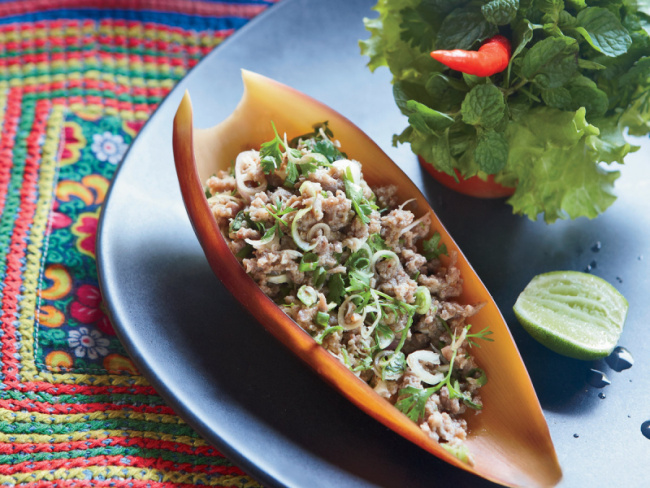
vietravel.com
Paeng Pet
Raw duck blood, or even pig or goat blood, is widely consumed in Laos. Fresh blood is a given, and the blood in this duck version is combined with cooked minced duck and organs, as well as heaps of Laos herbs like mint, green onions, and cilantro. They frequently include crispy shallots and peanuts. This combination of minty-ness, lime juice, and fire-hot from raw local chilies will set you on fire, despite being packed full of herbs and not even remotely resembling a vegetable dish. The rich, oily goodness of the fried duck meat, combined with its gooey and creamy blood, will have you returning for breakfast the next day.
This dish is a joy to eat, from spooning up the duck blood to squeezing out the lime juice and chasing each bite with a shrimp paste-covered green chili pepper. Friends from Laos were raving about this dish, saying we couldn’t miss it, and you should keep an eye out for Paeng Pet as well.
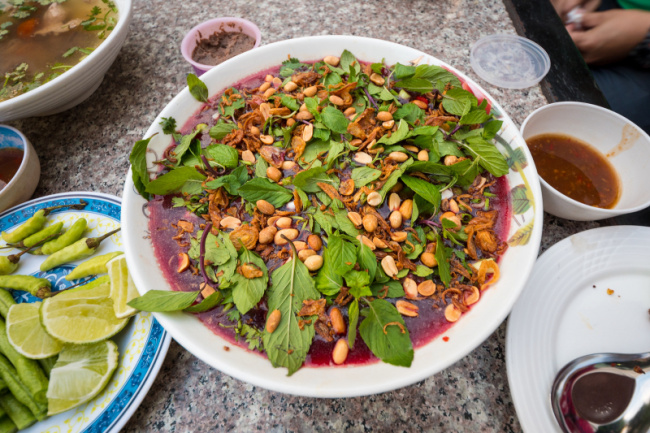
https://migrationology.com/
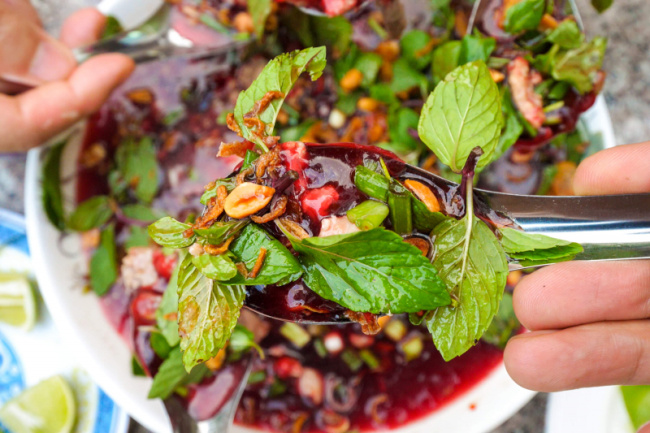
Jaew
Jaew can refer to any type of dipping sauce, which Laos has an abundance of. These dishes always include chili peppers and, more often than not, some type of grilled vegetable, which gives them a distinct smoky flavor, as well as fermented fish. This is a favorite dish in Laos, especially when served with sticky rice or vegetables.
The pounding action of smashing ingredients together with a mortar and pestle creates a deliciously strong flavor. Full of Laos’ favorite ingredient, the clay-pot fermented fish known as Pa Daek, this dish is umami to the max. The garlic and raw chilis come first, followed by fish sauce and a squeeze or two of lime. This base can then be transformed into any of a dozen recipes by adding a final vegetable and/or meat ingredient.
Some of the more common types include Jaew Ma-Keua (roasted eggplant) and Jaew Moo (pork meat and pork cracklings pounded together), which is eerily similar to Mexico City’s Chicharron Tacos. Another local Laos favorite is jaew bong, a chili dip made with dried chilies, garlic, galangal, shallots, and a little dried buffalo for flavor.
Because this is a smaller home-cooked dish, it is usually available at fresh markets and food markets.
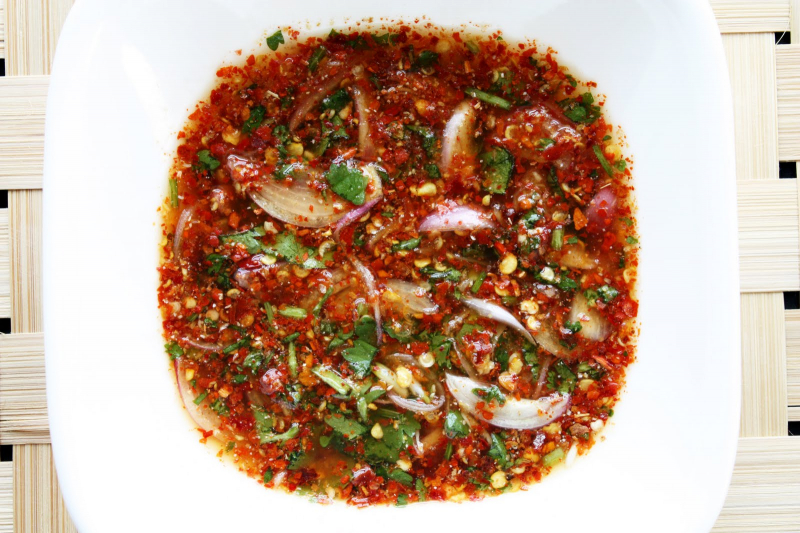
shesimmers.com

vietworldkitchen.com
Or Lam
Or Lam (but better pronounced aw lahm) is always made with animal fat (usually pork) rather than vegetable fat. Traditionally, tough yet flavorful buffalo skin is used, as well as Mai Sakaan, a magical ingredient that can only be described in English as ‘spicy chili wood.’
It’s an extremely earthy flavor combination that usually includes herbs like dill or holy basil, as well as a wild ingredient like mai sakaan. The broth is thick and sticky, and you can almost feel the potent nutrients among all that hearty flavor. The special wood ingredient is very fibrous and is meant to be chewed but then spit out, making for a tasty and fun bite that tingles the tongue slightly like Sichuan pepper. It is rich in the oils and juices produced by the long stewing times of various pork parts. Or lam is a delicious Lao dish.
It went perfectly with Sticky Rice. Sticky rice is also a must, and it was one of the most frequently ordered dishes on local tables when we visited Luang Prabang. This can be found in any higher-end Laos restaurant.
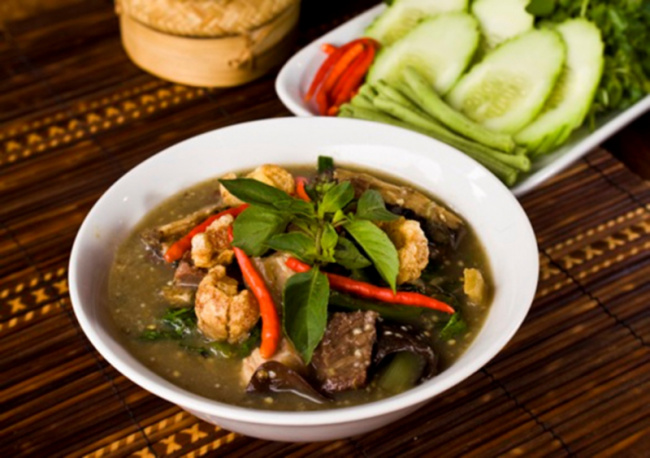
vnexpress.net
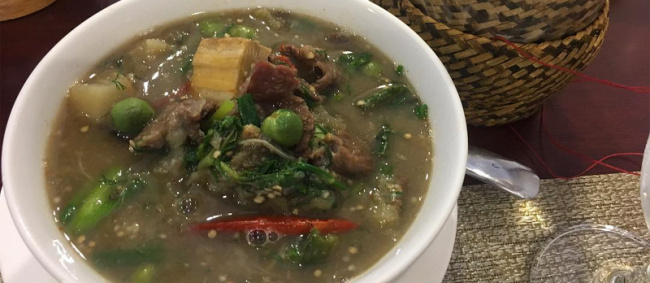
tasteatlas.com
Khao Piak Sen
This simple and satisfying bowl of rice noodles can be found on nearly every street corner in Laos, making it an excellent first meal on any full-day Laos food tour. This dish is popular in both Laos and neighboring Vietnam, and there’s a reason why it’s so well-known among travelers in the region.
It starts with a massively deep flavorful meat stock that takes hours to make. The chef is usually up before dawn, preparing a massive drum of soup and wheeling it to the front door of a restaurant. Keep an eye out for this stainless steel container, as well as a long line of excited people.
Khao Piak Sen is distinguished among rice noodle dishes by the use of thick, hand-rolled noodles. Instead of a typical watery soup, they blanch the noodles in the soup stock without removing the starch, giving the soup an almost gravy-like thickness. A small dish of fresh herbs, hot red peppers fried in oil (insanely good), shrimp paste, and sometimes dried crushed peanuts are served at the table.
It is one of the oldest dishes in Laos. This dish has been around for thousands of years, with the most well-known version made with rice instead of noodles. If you find it, don’t forget to ask the chef for a few slices of lime to elevate your rice soup.
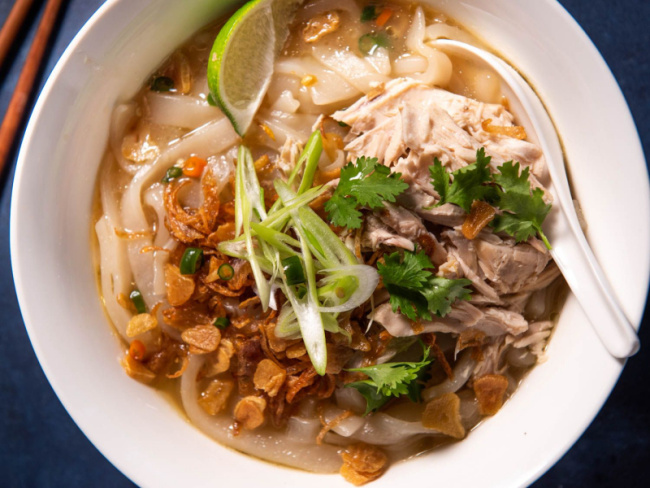
seriouseats.com

yong.vn
Khao Soi
Laos is such a relaxed country that the most common debate must be over which restaurant serves the best Khao Soi. The Laos version differs from the well-known Thai version in that it is made without the use of gati (coconut milk). Instead of the creamy, slightly sour Northern Thai version, when you try it, you’ll notice how cleanly you can taste the meat, a warming pork blend of tomatoey spices.
The minced pork is slow cooked for hours over a charcoal fire, with the chef turning the meat and mixing in roasted chilis and chili oil, as well as herbs crushed with a mortar and pestle. Galangal, lemongrass, and small Laos home-grown sour tomatoes are also present. This is a dish that will pique your interest as well as your appetite – guaranteed customer satisfaction.

foodandwine.com
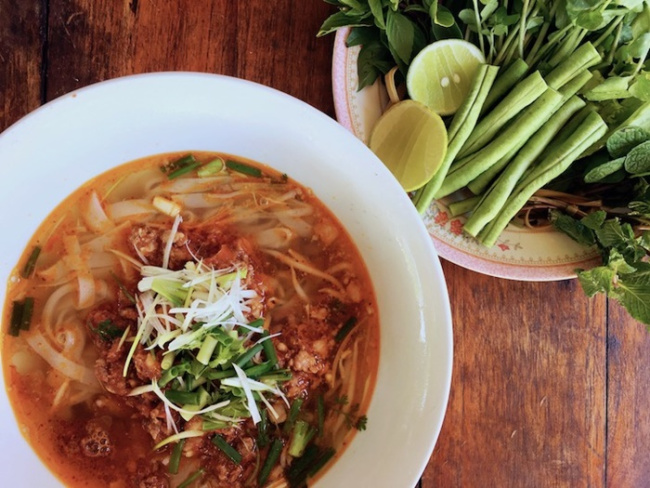
dulichvietnam.com.vn
Tam
When traveling in Laos, going a day without eating Tam is almost a challenge in and of itself. This is the staple of the Laotian diet, always served with sticky rice. The most common way to eat it is with wonderfully crispy shredded green (unripe) papaya, also known as tam mak hoong.
Each ingredient is pounded, sliced, or shredded, but they are all raw and go into a massive pestle one by one. This dish gets its name from the pounding of the mortar, also known as the ‘Tam’ action. However, referring to Tam Mak Hoong as ‘Papaya salad’ will not prepare you for what you’ll get when you order a great version. Pa Daek, the much-loved fermented fish sauce addition to nearly every aspect of Laos local cuisine, is nowhere more prominent than in this dish.
Mak Hoong translates to “Papaya,” but you can order it with any fruit or vegetable you see. Try pointing to something, saying ‘Tam’ (which sounds like ‘Thumb,’ and watching to see if the chef reaches for another handful of fresh chilis.
Using what you see around you is simply doing what Laos people have done for centuries – trying out anything that grows as something for fermented fish juices and mashed chilis to grab onto and soak up flavor.
Tam mak kluay, a green banana pounded mixture, is another impressive version that will blow your taste buds away. It will give you the same sensation as if every flavor center of your tongue were pushed to maximum stimulation. It was insanely sour, but also fully bitter amidst blazing chili heat, and also extremely umami – this dish has it all.
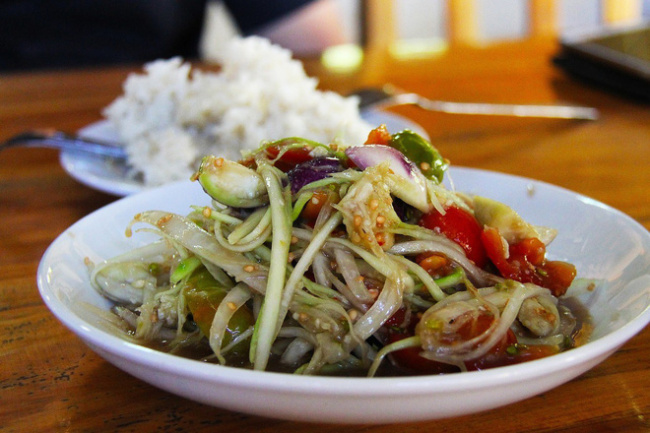
kaotours.com
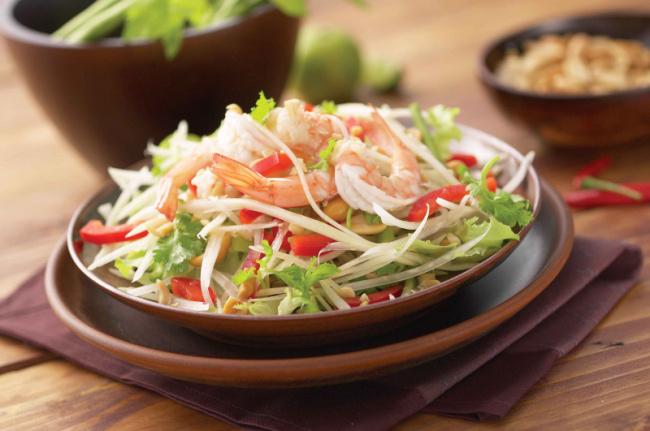
indochinavalue.com
Khao Jee Pa-Tay (banh mee)
The sandwich maker slices the bread lengthwise and then spreads a thick layer of pate on top – rich liver flavor, but also a sticky surface for all the veggies to grab onto. The pate is essential; without it, Khao Jee Pa-Tay would be incomplete. Then there are the strips of pork sausage, cucumber spears, whole green onions, carrots, and pickled turnips, and usually some pork floss. When your eyes are large enough to outnumber your stomach, finish with a few end-to-end layers of sweet and spicy red sauce.
The sandwich is divided in half, and most customers eat the first half while carrying the second half to-go. A full-option baguette will cost between 10,000 and 20,000 Kip, depending on your order, and to-go (smaller) ones can be purchased for as little as 5,000 LAK at the bus stop.

asialinkstravel.com
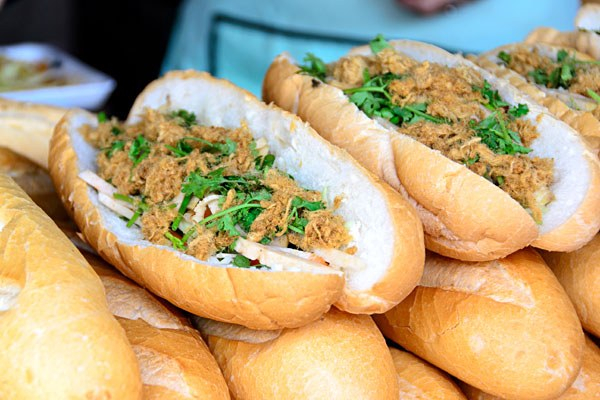
livingnomads.com
Sai Oo-ah
This is one of those Laos dishes that will have you ordering seconds before you’ve finished your first. It would be worth your time to visit Laos just to try these, as they are well deserving of a spot on the list of “World’s Best Meat Uses.”
Your thoughts will wander as your tongue revels in the fatty goodness and smoky aroma. Sai Oo-ah is the ideal sausage balance of firm, springy, and juicy – the flavor available in a single bite is incredible.
Every millimeter of this delectable little sausage is brimming with flavor. It can be made with a mixture of pork belly, skin, and minced meat, as well as diced galangal, chopped green onions, cilantro with a ton of dill, and, of course, a kick from fresh chili peppers. Eat it hot, straight from the grill, and get another two or three in a banana leaf packet to go.
The massive herb quantity is what truly distinguishes Sai Oo-ah from any other sausage in the world.
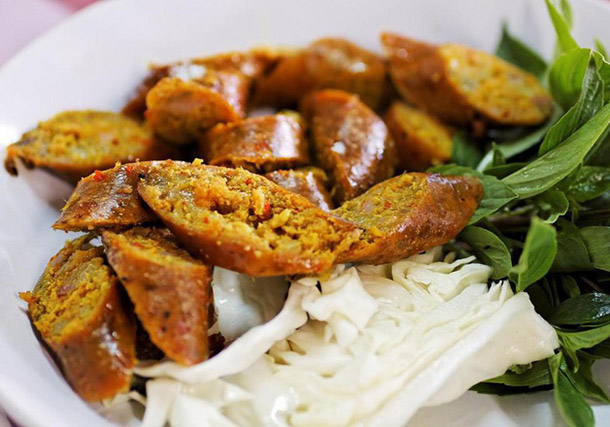
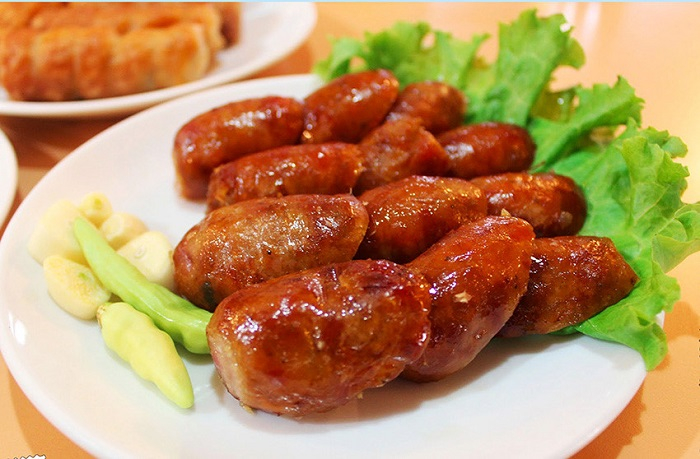
https://kaotours.com/
Naem
This sun-ripened pork delicacy is a must-have on any morning market stroll in Laos. Naem ferments to perfection, with gently sour flavors and mushy meat goodness. This pork mixture cooks with steam before being hung out for 1-2 days, usually in direct sunlight.
This dish is a beautiful and deliciously efficient way to use more than just the usual cuts of ribs, shoulders, or pork chops, as it contains various combinations of what may appear to be all the lesser used parts of the pig (and they most certainly are).
This dish makes use of everything that nature has to offer. Cartilage crunching, chewy skin goodness, not to mention the powerfully hot chili peppers, all smoothed together by your required dose of collagen, Naem is yet another example of how Laos cuisine is just full of ideas for how to make the best use of everything that nature provides. Lots of travelers highly recommended this dish as one of the Laotian must-try foods
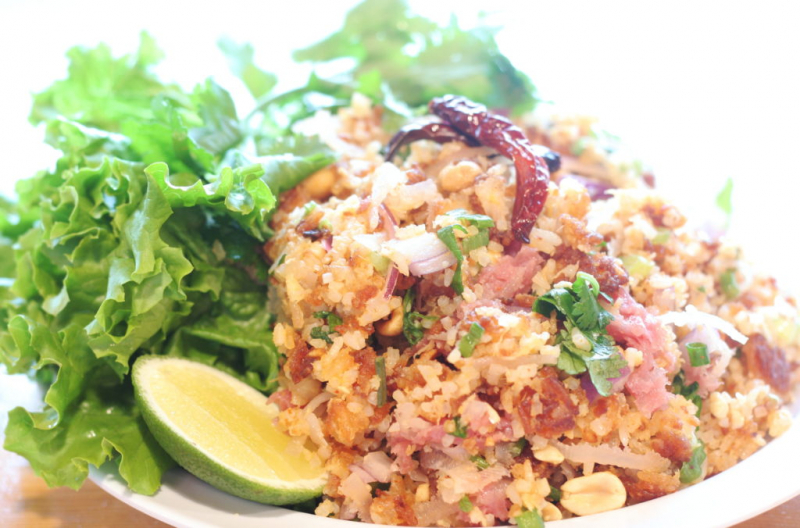
storynosh.com

asianalink.com
Mok
In Laos, a ‘mok’ is a banana leaf wrap with nearly infinite combinations. Using either banana or taro leaves, the cooking method is always steaming or roasting over coals.
When there are so many variations to try, opening one of these is always exciting. Fish, herbs, spices, and even pig brains are common ingredients in a good Mok. And occasionally, if you don’t know all of the ingredients, you’ll get what can be called a “Mystery Mok.” Many look similar on the outside, so you may have to pick a few from the grill until you find the one you’re looking for. Some chefs employ a toothpick placement system, with half-toothpicks or full toothpicks. Just buy one of everything and you’ll be set for life.
Lao style mok is delicious with sticky rice. You should definitely try the one with pig brains, Mok Samong, or the gooey and warm bamboo salad, Mok Naw Mai. There’s no food fun like a good morning Mystery Mok. Grills selling this will pop up anywhere, and it’s also common at markets like the Phou Si fresh market in Luang Prabang.
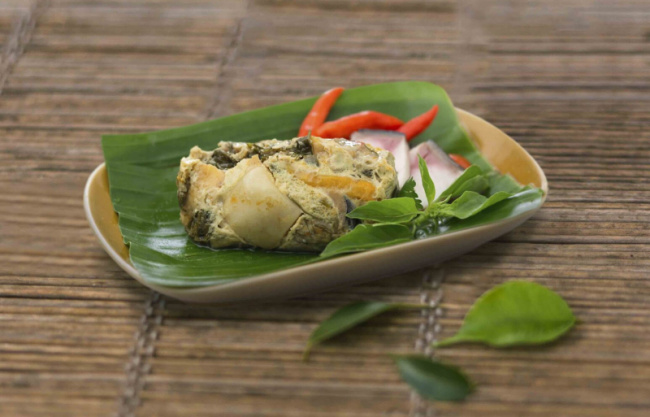
lasposas.com
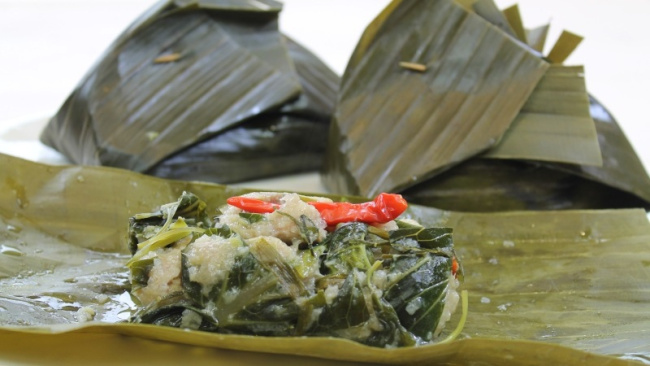
cookingwithmorgane.com
Soop Pak
Last but not least, this sour, herb and vegetable-filled mix with sesame seeds is another impressive dish on the Laotian menu. Soop pak comes in many varieties, some with string beans, others with spinach-like greens, and possibly a local version with cashew tree leaves.
The vegetables are typically blanched and mixed with herbs, with the most important ingredient being a large amount of sesame seeds to wrap it all together and give it its distinct nutty flavor.
Soop pak is commonly found at Laotian food stalls selling a variety of stews and jaew. If you ask for soop pak, they will almost certainly have some variation of it. Alternatively, it can be found at the night market just off the walking street in historical Luang Prabang.
If you plan a trip to Laos in the future, try this dish at least once. Your trip will not be complete without trying this dish. Many visitors are surprised by its unique taste and say that they had a good experience with it.
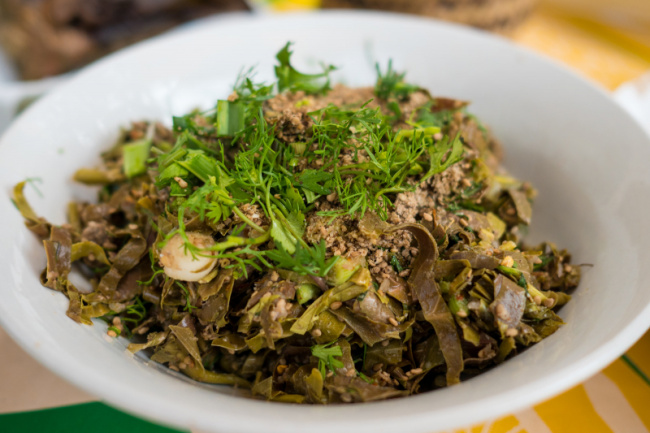
migrationology.com
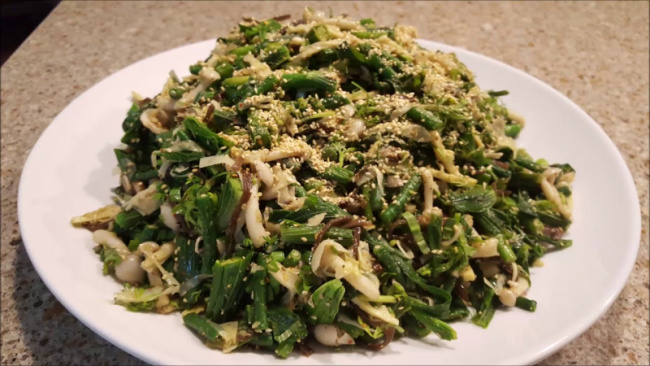
Photo: Mee Living’s Youtube Channel
